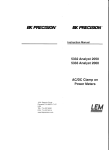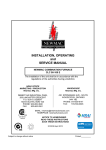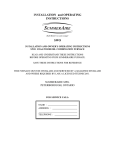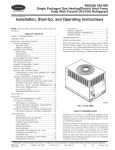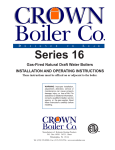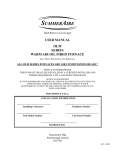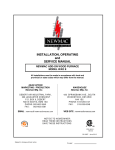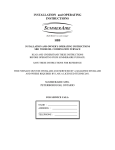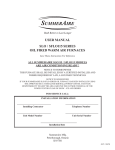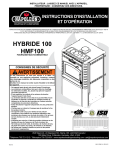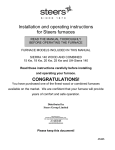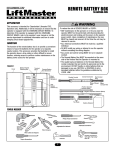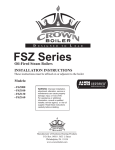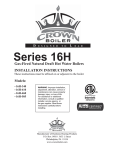Download YES - Heat Recovery Ventilators, Air Handlers, Furnaces
Transcript
INSTALLATION and OPERATING INSTRUCTIONS SBB100 Installation and Owner’s Operating Instructions COMBINATION Wood/Oil warm air FURNACE Read and understand these instructions before operating your Summeraire furnace. Save these instructions for reference This furnace must be installed and serviced by a qualified installer and where required by law, a licenced technician. SUMMERAIRE MFG. PETERBOROUGH, ONTARIO FOR SERVICE CALL: NAME: ______________________________ ADDRESS: __________________________ _____________________________________ TELEPHONE: ________________________ 1 Table of Contents Page# Shipping information . . . . . . . . . . . . . . . . . . . . . . . . . . .3 Installation . . . . . . . . . . . . . . . . . . . . . . . . . . . . . . . . .4 Controls . . . . . . . . . . . . . . . . . . . . . . . . . . . . . . . . . .8 Installation Tips . . . . . . . . . . . . . . . . . . . . . . . . . . . . . .11 Specifications . . . . . . . . . . . . . . . . . . . . . . . . . . . . . . .12 Shipping Weight . . . . . . . . . . . . . . . . . . . . . . . . . . . . . .13 Wiring Diagram . . . . . . . . . . . . . . . . . . . . . . . . . . . . . .14 Important Instructions . . . . . . . . . . . . . . . . . . . . . . . . . . .15 How to Operate . . . . . . . . . . . . . . . . . . . . . . . . . . . . . .16 Warranty . . . . . . . . . . . . . . . . . . . . . . . . . . . . . . . . . .26 2 INSTALLATION This furnace is shipped in two packages The Installer is responsible for ensuring that the packages have been received in good condition. Check packages for damage. Each unit is carefully inspected prior to leaving our factory. Package No. 1 Furnace complete with blower and motor assembled and installed; air filter and cleanout tool. Package No. 2 Oil burner with nozzle installed. Damper motor 2 – 24 volt thermostats - F-822K1034 1 – L4064R1134B Fan & Limit Control –limit set @ 250 º F – 11 _ insertion. No substitute 1 – Bracket for Fan & Limit control 1 – Blocked flue sensor 1 – R8A05A4 Interlock relay assembly 1 – 4” x 4” electrical mounting / junction box 1 – Wiring harness which includes all of the above noted controls (except thermostats ) completely connected into this assembly. The installation of this furnace must be in accordance with CSA B139 - 04 “Installation Code for Oil Burning Equipment” , and CSA B365.1-M91 “Installation Code for Solid Fuel and Combination Fuel Furnaces”. In the United States, UL391 Solid Fuel and Combination Fuel Furnaces Electrical and mechanical installations must conform to all local and National Codes and Standards. 3 INSTALLATION OF THE COMBINATION FURNACE Fig. # 1 CLEARANCE TO COMBUSTIBLES Fig. # 1 Top of Plenum 6” Front Side – Wood 48” One Side 6” Other Side 36” Rear36” Flue Pipe 18” Base or Floor – NON COMBUSTIBLE Duct 6” for first 6’ from appliance plenum Duct work may be reduced to 1/2” at 72” from plenum CAUTION : Flue Pipe to Controls - 12” LOCATION This furnace should be centrally located in relation to the outlet registers, with large warm air ducts, for improved heat distribution. The flue connection to the chimney should be short and direct and consist of as few elbows as possible. 4 ELECTRICAL All electrical equipment and wiring shall be installed following the requirements of the Canadian or U.S. Electrical Code, as well as regulations of local Authorities. FURNACE INSTALLATION The floor on which the furnace is to be installed must be non combustible. The furnace must be installed completely level in all directions. The wood burning portion of this furnace is designed to have a 2” layer of clean “washed” sand placed in the bottom of the wood burning combustion chamber. Equipment must be installed in a manner acceptable to the Regulatory Authority and only by mechanics / technicians experienced in such installations. When required by the Authority, such mechanics / technicians shall be licensed. THIS FURNACE IS NOT TO BE CONNECTED TO THE DUCTWORK THAT IS STILL CONNECTED TO ANOTHER FURNACE. NOTE Where fans are installed in the fuel storage area, they shall be installed so as not to create a negative pressure in the room where the solid – fuel burning appliance is located COMBUSTION AIR REQUIREMENTS It is the Installers’ responsibility to determine if outside combustion air is required. An outdoor combustion air opening shall be at least 2000 mm _ in area plus 100mm _ per KW input over 18KW ( 3.2 in _ plus 0.055 in _ /1000BTUH ). Note : 18 KW is equivalent to a burn rate 2.8 kg/h ( 6.3 lb. / h ) for typical firewood If a duct is used to convey air from outdoor combustion air opening to the appliance it shall ( a ) have a cross sectional area at least twice that of the minimum required outdoor combustion air opening. If the duct is longer than 3 m ( 10’ ), the effective cross sectional area of the duct shall be increased by 10% added metre of duct run 3.2% per added foot of duct run ) ( b ) be so designed or insulated as to prevent condensation on the outer surface of the duct for its full length. Where the duct is insulated, it shall have insulation with an RSI of not less than 0.5 ( R-3 ). Joints in the duct shall be sealedand the insulation shall be encased in an airtight and vapor – retardant membrane. 5 ( c ) have a minimum interior dimension of 50 mm ( 2 in ) at any point along its entire length, unless certified for a lesser dimension. ( d ) terminate at least 0.3 m ( 1 ft. ) from the air inlet of the appliance, and shall be designed to prevent the intrusion of embers. ( e ) be either of noncombustible construction , or any combustible portion shall comply with the required clearance from the appliance for combustibles. SOLID FUEL DAMPER CONTROL Fig. # 2 The thermostat for the solid fuel section activates the damper control - which in turn moves the damper “flap” It is essential that the damper control is at all times in perfect working order. NOTE: Adjust damper chain so that the damper “ flap “ opens no more than 1 1/8” An open link in the chain shall be provided to allow the homeowner to immediately stop the combustion air entering the wood combustion area – SEE Fig . # 2 The damper door on the SBB100 has an opening limited to 1 1/8” by a tab and screw arrangement. This is the maximum combustion air that this required for this furnace to operate. Any tampering with this device will cause an out – of – control fire. Make sure that the wood section loading door or other openings are not left in the open position after loading the wood section with fuel or removing the ashes. Excessive air decreases the oil burner efficiency. CHIMNEY & SMOKE PIPE The specification of the chimney to be used, must comply with the requirement that, other than solid fuel / oil combinations and Add – Ons, wood burning appliances shall not be connected to a venting system vented by another type of fuel. An existing chimney should be thoroughly inspected and cleaned to ensure safe furnace operation. If a factory built chimney is used, it must be certified to CAN/ULC S629 ( HIGH TEMP ). If a masonry chimney is used, it must comply with the National Building Code or CSA B1398. for such chimneys including approved vitreous clay or stainless steel linings. It is very important that the chimney has an adequate capacity and develops sufficient draft for proper combustion - .03” to .05” WC at the flue connection of the furnace, and .01” to .03” WC draft over the fire. Maximum chimney draft should never exceed - .05” WC. Since power failure could cause the fire to burn out of control. 6 Minimum inside chimney 28.27 sq. inches. The smoke pipe shall be full size and not lighter than 24 ga. or heavier “blue” or black ( coated or painted ) steel. WARNING Do not install flue / smoke pipe close to or in front of Limit and Operating Controls. BAROMETRIC DAMPER The barometric damper ( draft regulator ) may be located on either the vertical or horizontal section of the smoke pipe. The best location is 18” from the furnace flue outlet. The Barometric Damper must always be level ( without leaning forward or backward ) and the pivoting axis must be horizontal. Follow the directions for installation which is supplied with the Barometric Damper. OIL TANK Refer to current edition of CSA B139-04 – OR the most recent version of this Standard. The oil supply tank and fuel oil lines shall be installed in accordance with standards and codes in effect in your area. • • • • An oil filter must be installed at the oil tank after the oil valve. The oil line must be protected when installed. All oil line connections must be made using FLARE fittings. Connect oil line to burner. OIL BURNER INSTALLATION This furnace can be multifired by selecting the appropriate nozzle and pump pressure, also you must select the correct blower /pulley / belt combination from the Specifications shown on page 8. The oil burner is flush mounted with 3 positioning bolts on the burner mounting area under the wood fire door. Carefully install the burner mounting gasket prior to mounting the burner. Check nozzle size and tightness. Set up burner to “Trace” smoke. CO2 readings should be between 12 and 13.7 % depending on U.S.G.P.H. input. 7 Note: Beckett Model AFG burner is factory supplied with pump pressure set at 140 psi. If the .60 U.S.G.P.H nozzle is used / installed, the Low Fire baffle supplied with the burner must be installed. If 1.00 U.S.G.P.H nozzle is installed PUMP PRESSURE MUST BE ADJUSTED TO 130 P.S.I. CONTROLS The externally mounted controls included with this furnace are; 1 – L4064R1068 Fan & Limit Control – limit set @ 250 º F 1 – R8285D5001 Interlock relay assembly 1 – Bracket for Fan & Limit controls 1 – 4” x 4” electrical mounting / junction box 2 – 24 Volt Thermostats 1 – Blocked flue sensor The externally mounted controls may be installed on either side of the furnace cabinet. An electrical “knockout” and fan and limit bracket mounting holes are provided on each side of the cabinet. Select the cabinet side desired for installing the junction box and BX wiring harness assembly and Fan and Limit Control, remove the electrical “knockout” plug. The blower wiring harness is connected to the motor and is coiled in the blower cabinet for easy access. The junction box, interlock relay assembly, fan and limit controls, and blocked flue control are all completely prewired in the “BX” cable wire harness assembly shipped with the furnace, and include the BX fastening clips. Feed the blower wire harness from the blower compartment through the “knockout” ready for connection into the junction box wiring. Mount the junction box and connect the external power supply to “L1” and “L2” in the junction box and the blower wiring. Attach the fan and limit bracket using the predrilled holes provided in the side of the cabinet. Provide two ( 2 ) holes in the supply air plenum using the holes in the bracket as a locating guide. Mount the two ( 2 ) fan and limit controls. Install the blocked flue switch 10” from the furnace breech. Using the “BX” clips provided, attach the wiring harness to the furnace cabinet in a neat workmanlike manner. 8 Install the furnace disconnect switch in a convenient location outside of the furnace room. Set Fan / Blower speed to obtain a temperature rise of 28 º - 30 º C ( 83 º - 85 º F ) during oil burner operation Finally, prior to connecting to 115/1/60 power source. • Check all electrical connections for tightness • Check for proper grounding of furnace • Check for proper electrical operation. THERMOSTATS Two thermostats are supplied with this Summeraire combination furnace. One thermostat controls the oil section and the other thermostat controls the wood section. Select a location which is representative of the average house temperature, usually the living room, or other “living area” location. The thermostats should be mounted on an inside wall, never where they will be subjected to drafts ( warm or cold ), above any appliance or the sun’s rays or heat from registers may affect the sensing elements in the thermostats from accurately controlling the temperature in the home. See instructions supplied with the thermostats. CLEANOUTS It is very important to clean the heat exchanger at least on an annual basis One cleanout cover is located on the front of the furnace above the Firebox charging door To access this cleanout, remove the painted stand- off cover. Remove cleanout cover nuts and carefully remove the cleanout cover gasket Using a stiff brush, brush the tubes which have been exposed by the removal of the cleanout cover clean of any accumulation of soot or creosote that may be present. Reassemble the cleanout assembly in reverse order. One clean – out access cover is located on each side of the furnace. These covers permit access to the cleanouts located in the secondary heat exchanger. Use a wire brush to loosen the soot and creosote present in this area. Remove with a suitably approved vacuum cleaner designed for this purpose. NOTE: If the cleanout cover gaskets are damaged, replace with factory supplied gaskets prior to reassembly. FRONT CLEANOUT ACCESS 9 Fig. #2 DUCT CONNECTION The return air duct connection should be tight, so that the blower cannot draw air from the furnace room which can interfere with the combustion air supply. A plenum chamber or an elbow type connection may be used. Sufficient air flow must be provided for efficient operation. An opening into the furnace room shall be made to the outdoors if there is not sufficient air infiltration. The equipment shall be installed in accordance with the standards of the NATIONAL BOARD OF FIRE UNDERWRITERS. Authorities who have jurisdiction should be consulted before installations are made. RETURN AIR DUCT SYSTEM Return air ducts must be galvanized duct or a galvanized lined joist space covered with joist “panning”. NOTE: Return air joist lining is not permitted over an unprotected joist space. NFBU STANDARDS INCLUDE: Standards for the installation of oil burning equipment. NFBU No. 31 Standards for the installation of air conditioning, warm air heating and ventilating system. NBFU No. 90 Building Code standards for the installation of heat – producing appliances, heating, ventilating, air conditioning, blower and exhaust system. 10 INSTALLATION TIPS Minimum Duct Sizes Supply Air 8” X 22” Return Air 8” X 24” The Supply Air and Return Air extended plenum size should be the same as “minimum square inches “ shown in above table for the first 8 – 10 ft. from furnace, then gradually reduced to the end of the duct system. • Use a minimum pipe size of 6” in diameter in runs and never smaller than 5” • Set blower C.F.M. to obtain 29 º - 30 º C ( 83 º - 85 º F ) temperature rise through unit, when fired on oil. INSTALLATION OF CENTRAL AIR CONDITIONING If a Central Air Condition System is to be installed in conjunction with a SBB100 furnace, the following is the ONLY installation method that is recommended by Summeraire Mfg. Use an “H” coil ONLY The “H” coil shall be installed in the “extended plenum” An enlarged section may be required in the extended plenum to accommodate this coil. FINALLY We stress that it is your obligation to see that: 1) Homeowner receives a ) Owner’s “User Manual” b ) This set of Installation Instructions 2) That the installation is made in accordance with C.S.A. Installation Standard B139-04 / B365-M91 or the National Building Code or NBFU No. 31 3) Homeowner is fully instructed in operating this furnace, and in all procedures necessary to insure its complete and safe operation. 11 SPECIFICATIONS – SBB100 BURNER NOZZLE BECKETTBECKETT BECKETTBECKETT “AFG”“AFG” “AFG”“AFG” .60–60 º W DELEVAN .75–60 º W DELEVAN .85–60 º W DELEVAN 1.0 –70 º W DELEVAN PUMP PRESSURE 140140 140130 B.T.U. INPUT 90251115015128955144130 B.T.U. OUTPUT 77706 98223 110385 116745 20” X 20” 20” X 20” 20” X 20” 20” X 20” BLOWER – BELT DRIVE G10 G10 G10 G10 BLOWER MOTOR - HP 1/3 1/3 1/2 AIR FILTER 1/3 BLOWER PULLEY 7”6” 5”5” MOTOR PULLEY 3 1/4” 3 1/4” 3 1/4” 3 1/4” MOTOR PULLEY – TURNS OPEN 1/2 1/2 1/2 0 BELT 3937 3636 C.F.M. @ 0.2 “ ESP 940 1190 1320 1500 .85 – 60 º W DELEVAN 1.00 – 70 º W DELEVAN Factory Supplied Nozzle : .75 60 º TYPE W DELEVAN OPTIONAL DIRECT DRIVE ASSEMBLY NOZZLE .60 – 60 º W DELEVAN .75 – 60 º W DELEVAN PUMP PRESSURE 140140 140130 B.T.U. INPUT 90251115015128955144130 B.T.U. OUTPUT 77706 98223 110385 116745 20” X 20” 20” X 20” 20” X 20” 20” X 20” DIRECT DRIVE BLOWER G10DD G10DD G10DD G10DD BLOWER MOTOR HP 1/2 HP 1/2 HP 1/2 HP 1/2 HP 940 1190 1320 1500 AIR FILTER C.F.M. @0.2” ESP Factory Supplied Nozzle : .75 60 º TYPE W DELEVAN 12 SBB100 – DIMENSIONS Fig. #3 Space between plenums 1 7/8” Firedoor opening 13” X 9” Wood Firebox 18”W X 23”L Total overall length including oil burner 64 1/2” SBB100 SHIPPPING WEIGHT: 575 pounds 13 14 Thermostats Wood Oil Damper Motor M Oil Relay Flame Sensor D G O W C R T T T T Orange White Black Black White Blocked Vent Switch Black White G Manual Fan Switch Fan & Limit Controls WIRING DIAGRAM SBB100/SBB137 Red L1 L2 White Orange L4064R1134 with Manual Reset High Limit Switch Fan side is not used Limit set at 250°F 12/08 Field Wired Burner Motor Blower Motor Note: Fan speed may require change to achieve temperature rise specified in instructions 110V Supply 60 Cycle with 15A Time Delay Fuse White IMPORTANT :THESE INSTRUCTIONS SHALL BE READ AND UNDERSTOOD BY THE HOME OWNER Your Sumnmeraire combination wood / oil furnace is controlled automatically. This furnace is shipped with two thermostats, One thermostat controls the Oil Burner and the other thermostat controls the Wood fire These entire instructions shall be read to ensure the best possible operation and safest use of this furnace. Manufacturer’s recommendations and codes set down by the Regulating Authorities must be followed when installing and operating the furnace. ALL solid fuel burning furnaces manufactured by Summeraire Mfg. have been tested for safety by the Canadian Standards Association Laboratories and carry their Certificate of approval which is recognized by Insurance Underwriters in Canada. WARNING! • DO NOT USE CHEMICALS OR FLUIDS TO START THE FIRE • NEVER FIRE WITH TREATED WOOD, OR BURN GARBAGE, GASOLINE, NAPTHA OR ENGINE OIL • DO NOT FILL THE FIREBOX ABOVE THE BOTTOM OF THE SMOKE BAFFLE, LOCATED AT THE TOP PORTION OF THE FIREDOOR OPENING •DO NOT STORE COMBUSTIBLES INSTALLATION CLEARANCES. WITHIN THE MINIMUM • BUILD A SMALL INTENSE FIRE AT LEAST ONCE A DAY TO REDUCE CREOSOTE BUILD UP. • CLEAN CHIMNEY AT LEAST ONCE A YEAR, AND INSPECT REGULARLY FOR CREOSOTE BUILD UP • FOR SAFETY, KEEP FIRE CHARGING DOOR TIGHTLY CLOSED. • DO NOT ADJUST ELECTRICAL CONTROL SETTINGS OR BLOWER PULLEY ARRANGEMENT. • OPERATE OIL SIDE OF UNIT ONCE A WEEK TO ENSURE THAT IT WILL OPERATE SATISFACTORILY WHEN NEEDED. 15 • KEEP FIREDOOR CLOSED AND MAINTAIN ALL SEALS IN GOOD CONDITION. • MAKE SURE ADEQUATE COMBUSTION AIR IS PROVIDED IN FURNACE AREA. • DO NOT START WOOD FIRE IF OIL VAPOR IS PRESENT. • LEAVE A MINUMUM OF 2” OF SAND OR ASH ON THE BOTTOM OF THE WOOD FIREBOX. • DO NOT USE FLUIDS, GASOLINE, OILS OR CHEMICALS TO START A FIRE. • DO NOT BURN GARBAGE, PAPER ( except to start the fire ) TAR PRODUCTS, GASOLINE, OILS, PLASTIC, DRIFT WOOD OR MATERIALS CONTAING SALTS OR CHEMICALS. THIS IS EXTREMELY DANGEROUS AND WILL VOID THE WARRANTY. • THIS FURNACE IS NOT TO BE CONNECTED TO OR USED WITH AN AUTOMATIC STOKER OR SAWDUST BURNER. WOOD SECTION OPERATION This unit is not to be connected to or used with an automatic stoker or sawdust burner. Solid fuel fires require sufficient supply of air for combustion. Combustion air is required above the fire bed. Keep the furnace smoke pipes and chimney clean. This will increase efficiency and reduce the risk of excess soot and creosote fires. This furnace, smoke pipes and chimney should be should be inspected monthly. FIRING Start the fire in your furnace with paper and kindling only. Crumple a quantity of paper and place it on the “floor” of the fire box. Randomly stack kindling on top if the paper allowing for good combustion and air circulation. Set your “ Wood “ thermostat so that it is 7 – 10 degrees higher than room temperature. This will open the draft damper allowing combustion air into the furnace. 16 Light the paper and close the fire charging door. When the kindling is burning well, put in some hardwood and allow this to begin burning. Add Hardwood : do not fill the fire box above the bottom of the smoke baffle located at the top portion of the firedoor Fig. #1 Do not put too much wood at one time during initial start – up as you could smother the fire. When fire has been established properly, set “ Wood “ thermostat to your desired setting. The thermostat controlling the “Wood” section should be set at least 5 º above the “Oil” section thermostat, i.e. set “Oil” section thermostat at 18 º C ( 65 º F ) and the “Wood” section thermostat at 21 º C ( 70 º F ) LOAD FUEL CAREFULLY OR DAMAGE MAY RESULT MAINTAINING THE FIRE You will be required to maintain the fire in your furnace manually. The rate at which you will have to charge your furnace will vary with the size of house, type of wood, and weather conditions. When the fire in your furnace is not great enough to properly heat your home, the air circulation blower fan will begin to come on more frequently. In a few days you will establish the basic recharging period for your specific application. It is better to build small intense fires than building large smoldering fires as they reduce creosote build up. WHEN BURNING WOOD; DO NOT FILL THE FIREBOX ABOVE THE BOTTOM OF THE SMOKE BAFFLE, LOCATED AT THE TOP PORTION OF THE FIREDOOR - FIG. #1 DO NOT OVERFILL Combustion air is supplied into and over the fire through the “damper door and chute” assembly. This arrangement helps to retard the formation of creosote in the flue system. Operate “Oil” burner one day a week to help reduce creosote formation. Clean filters at least once a month and replace with new filters twice a year, unless conditions require more frequent replacement. If air flow is obstructed, the furnace will run longer and waste fuel ! Oil blower motor and burner motor where oil “holes” are provided at least twice a year with number 20 non detergent oil, 2 drops only for each “oil hole” Do Not Oil Blower Bearings ! A fixed “LIMITER“ device is installed on the damper door of your furnace. DO NOT TAMPER WITH THIS DEVICE! 17 ASH REMOVAL 1) Allow fire to burn out 2) Turn “ Wood “ thermostat to its lowest setting. This de-activates damper motor and allows the d amper door to close. 3) Remove ash with clean – out tool provided. 4) Ash is to be disposed of in a steel container with a tightly fitting lid, and moved out of doors immediately. Other waste shall not be placed in this container. 5) After ash removal, return “Wood” thermostat to normal setting and restart fire. OUT OF CONTROL FIRES These can be caused by excessive fueling – build up of creosote – too much draft • • • • Stop the flow of combustion air by lowering the thermostat to its lowest setting and unhook the damper motor chain ( an open link is provided in the chain for this purpose ). Fig. #1 Reduce the draft by fully opening the barometric damper. Excess heat can damage the safety controls. Your complete furnace, chimney and controls should be checked by a qualified technician prior to restarting the unit. WOOD SECTION - OPERATION DURING POWER FAILURE • Remove blower compartment door and air filter • If necessary, insert a space under the “damper door” to provide combustion air to the fire. • Fire at not more than _ normal firing level • Open all warm air registers and dampers • Check fire at frequent intervals to ensure safe operation. • DO NOT OVERFIRE YOUR FURNACE DURING POWER FAILURE – A POTENTIALLY DANGEROUS SITUATION WILL RESULT. NOTE: When power has been restored, remove space from under the “damper door” ( if inserted ). Reinstall blower compartment door. 18 FURNACE MAINTENANCE AND CARE Establish a routine for the storage of fuel, care of the appliance, and firing techniques. Check daily for creosote build up until experience shows how often cleaning is necessary. Be aware that the hotter the fire, the less creosote will be deposited, and weekly cleanings may be necessary in mild weather though monthly cleanings may be enough in the coldest months. Have a clearly understood plan to handle a chimney fire. To control creosote when burning wood in temperate weather, stoke often with a small intense fire. Heat requirements should determine the size of the Wood fire. To help control creosote build up in the furnace, burn well seasoned hard wood, sun – dried in an open area for at least 12 months. Do not allow any wood fire to smolder and cool the flue system as this type of operation condenses the flue gas products creating creosote. DO NOT OPERATE YOUR SUMMERAIRE COMBINATION FURNACE WITH THE WOOD CHARGING DOOR OPEN ! CLEANOUTS It is very important to clean the heat exchanger at least on an annual basis. One cleanout cover is located on the front of the furnace above the firebox “charging” door. To access this cleanout, remove the painted “stand – off” cover. Remove cleanout cover by removing the nuts and carefully remove the cleanout cover gasket. Use a wire brush to clean the secondary heat exchanger tubes to loosen any accumulation of soot or creosote that may be present. One clean – out access cover is located on each side of the furnace. These covers permit access to the cleanouts located in the secondary heat exchanger Use a wire brush to loosen soot and creosote present in the area. Remove residue from the designated cleanout areas with a suitably approved vacuum cleaner designed for removing this material All cleanout gaskets should be replaced after each cleanout is carried out. NOTE : It is recommended that clean out of the secondary heat exchanger and complete furnace be carried out by a qualified technician and where required by law, a licensed technician. 19 CHIMNEY FIRE • • • • • • Call the fire department Make preparations to leave the house. Shut off main power switch to the furnace. Close all combustion air openings in the furnace to reduce the fire size. Do not remove the smoke pipe(s) until the fire is completely out. Inspect the chimney and repair as necessary after any chimney fire. Do not use the furnace until these steps have been affected. OIL SECTION NORMAL OPERATION When operating with the oil burner, the furnace will cycle on call from the oil thermostat as an oil furnace operates. When the oil burner starts, the damper which controls the wood fire will close automatically. When using the wood section, the wood thermostat will cause the damper motor to open the damper door on a call for heat, closing when the wood thermostat has bee satisfied. Should the temperature in the warm air plenum reach its highest allowable limit ( 230º F or 110º C ), the damper motor will close the damper door and the oil burner will not start, the blower will continue to operate. When the temperature returns to normal levels, the normal cycle will start. OIL SECTION OPERATING INSTRUCTIONS • • • • • • • • • • Use No 2 furnace oil ONLY Do not use gasoline, crankcase oil, or any oil containing gasoline. Do not attempt to start the burner if excess oil has accumulated, when the furnace is full of vapor, or if the combustion chamber is hot. Do not start the burner unless the blower access door in place. Press the burner relay reset button ONLY TWICE; if the burner fails to start, call an Oil Burner Technician. If the oil burner is to be shut off for any period of time, shut the oil valve OFF at the oil tank. Do not adjust or tamper with the furnace or any of the controls Do not burn garbage or paper in the oil section of the unit. Never leave paper, rags, or other combustibles around the furnace. Only qualified, or where required by law, a licensed technician shall set – up this unit and adjust controls. 20 STARTING THE OIL BURNER • • • • • • Do not start the burner if the combustion chamber is hot or if oil vapor is present. Make sure all valves installed on the oil line are open. Turn the main oil burner switch – ON Set the oil thermostat at a point above room temperature. If the oil burner fails to start immediately, turn the main oil burner switch ‘OFF’ and call a qualified service technician. If the oil burner starts to operate normally, leave the switch in the ‘ON’ position and reset the thermostat to the desired temperature. TO TURN THE BURNER OFF • Turn the main oil burner switch to ‘OFF’ • Set the thermostat as far below room temperature as possible. IF BURNER IS TO BE SHUT OFF FOR AN EXTENDED PERIOD. • Turn main oil burner switch to ‘OFF’. • Close all oil supply valves. • The heating system should be checked and cleaned if necessary. RESTARTING BURNER AFTER EXTENDED SHUT DOWN. The complete oil burner should be checked and serviced by a qualified technician. • • • • • Check oil pump strainer Replace oil filter cartridge Check electrodes Oil burner motor ( see lubrication section ) Restart burner by following instructions in; “STARTING THE OIL BURNER“ section. BURNER FAILS TO OPERATE Always call a qualified technician 21 The trouble may be : • Raise your “Oil” section thermostat to 5 º C ( 10 º F ) above present room temperature • Make sure your “Oil Burner” power switch is in the “ON”position • If you hear a hum from the oil burner, and the motor has not started, press the reset button on the burner motor once only. • Blown fuse in electrical panel • Thermostat may be set below room temperature. • Burner relay ( combustion control ) may have to be “reset” ( press reset once only ) • Oil valve may be closed. • Oil supply may be too low. • Manual rest fan and limit control may be “tripped” • Blocked flue sensor “tripped” • If the oil burner fails to start or runs for only a few seconds, call a qualified service technician. OIL BURNER SERVICE The oil burner and furnace should be thoroughly serviced annually by a qualified service technician, and where required by law, a licensed technician. AIR FILTER The air filter should be replaced at least every 3 months, more often if unit is located in a dusty location ). The replacement air filter shall be C.S.A. certified. DO NOT USE PLEATED TYPE AIR FILTERS IN THIS APPLIANCE. OIL FILTER The oil filter cartridge should be changed annually when annual service is carried out. GENERAL MAINTENANCE • Keep the heat exchanger clean. Soot does not conduct heat. A dirty furnace requires more oil to heat a home than a clean one. • The smoke pipe should be removed at least once a year and thoroughly cleaned. • Ensure that the furnace, flue pipe and chimney are cleaned at the end of the heating season. 22 CONTROLS The controls on your Summeraire SBB100 combination furnace are factory set. DO NOT TAMPER WITH THESE CONTROLS OR THEIR SETTINGS WARNING! SAFETY CONTROLS DO NOT TAMPER WITH OR ADJUST THE FACTORY SETTINGS OF THESE CONTROLS. Your Summeraire combination wood / oil furnace is equipped with two ( 2 ) safety controls These controls are located on either the right or left side of the furnace. One of these controls is a “Fan & Limit” control. “FAN” portion of this control senses when the air in the plenum chamber is warm enough to activate the air circulation fan. As the fire / heat cools down, and reaches the “OFF” setting of this control, it turns the air circulation blower OFF “LIMIT” portion of this control senses if for some reason, the temperature in the plenum chamber exceeds the maximum temperature set in the Fan & Limit control. If this temperature exceeds this temperature, the damper door ( controls the wood fire ) closes, OR, the oil burner shuts OFF. The circulation blower continues to operate until the air temperature in the plenum returns to a point below the factory set temperature. The other safety control, with a RED button and located beside the above control is a secondary “safety” limit control. This control is a “safety override” control and acts as a back – up control in the unlikely event that the above noted Fan & Limit control fails. This factory set Limit Temperature of this control is set slightly higher than the limit portion of the Fan & Limit control detailed above. This control will shut down the furnace as noted in the above noted control. The circulation blower continues to operate until the temperature is reduced to a point below the factory setting. This control will not allow the furnace to “restart” under any conditions UNLESS the RED button is pushed. HOWEVER, remember, this control activated due to failure of the Fan & Limit control. Therefore the RED button should not be activated unless you have thoroughly examined the cause of the failure of the Fan & Limit control, or what caused the “safety” limit to operate. We strongly recommend if this situation occurs, that you call a service technician as soon as possible and have a complete inspection of your furnace completed. THIS IS A SAFETY CONTROL – A DANGEROUS SITUATION WILL RESULT IF PROPER PRECAUTIONS ARE NOT OBSERVED. 23 CREOSOTE – IMPORTANT WOODBURNING INFORMATION Creosote is the black tar – like substance that forms on the heat exchanger, flue pipe and chimney when burning wood. Wood combustion is never complete, a visible sign is smoke coming from your chimney. Wood, when freshly cut, can contain as much as 50% moisture, depending on the type. Air dried wood, when dried under ideal conditions, will still contain approximately 20% moisture. The moisture, along with flue gas products, are vented outside by way of the flue pipe and chimney. Flue gas products, when chilled, condense into liquid creosote which may become a crystal ( solid form ) as temperatures increase with heat requirements. The heat control method on furnaces when burning wood, is the size of the fuel charge along with the control of combustion air, to increase or decrease the rate of burning which governs the heat output. To help prevent creosote in both “grate and base burner” types, burn dry seasoned wood, hard wood is more desirable than soft wood. Govern your wood load with the heat output required. Spring and fall require frequent small charges. A small intense fire produces less creosote. Short flue pipe runs help to keep the gases above the dew point. An interior chimney holds and retains heat longer resulting in less condensation than an exterior chimney. A good draft produces a hotter fire and exhausts the flue gases outside more rapidly at higher temperatures preventing condensation of flue products. A combination furnace in need of cleaning, will have poor draft creating a lazy fire and eventually, if ignored, may smoke around the doors when the oil side is running with a wood fire. (poor draft in a clean system can also produce smoking around the door). This choked condition with soot and creosote can only be relieved by cleaning the entire system as frequent as necessary, if neglected, it will cause a chimney fire, which could result in property loss and danger to the lives of the occupants. Wood burning equipment must be vented into a factory built Or vitreous clay or stainless steel lined masonry chimney. Chimneys must be built to Building and Energy Board Standards. Do not neglect cleaning, or deliberately set your chimney on fire to burn out the soot and creosote. If no damage is done to the 24 house, there will be damage to the chimney caused by extreme heat. Not even the best chimneys are designed to withstand repeated chimney fires. FACTORY BUILT CHIMNEY MUST BE LABELED THAT IT COMPLIES WITH UNDERWRITERS LABORATORIES CANADA ULC - 629 – M Figure #1 25 LIMITED WARRANTY MODEL SBB100 Summeraire Mfg. warrants , on a limited basis, this furnace to be free from defects in manufacturing as follows: 1) The Heat Exchanger is warranted for a period of 10 years as detailed below. 2) Electric controls, oil burner and outside casing ( or jacket ) are warranted for a period of 1 year from date of installation. (Copy of Bill of Sale must be provided to confirm installation date). HEAT EXCHANGER LIMITED 10 YEAR WARRANTY Cost to owner of replacement heat exchanger expressed as a percentage of the retail price in effect at the time of shipment of the replacement heat exchanger. First 5 years after date of original installation 0 % ( replaced no charge ) From year 5 through year 6 20% From year 6 through year 7 40% From year 7 through year 8 50% From year 8 through year 9 60% From year 9 through year 10 80% From year 10 and over100% The foregoing warranty applies only where installation has been made in full accordance with Federal and Local Laws and Codes or ordinances applying to installation of wood or combination wood / oil warm air furnaces, and failure is not caused by abuse, or failure to observe proper operating instructions and cleaning suggestions accompanying the furnace; furnace has been fired with the proper type of fuel and maintained in accordance with our instructions; furnace has not been fired at an output in excess of its rated or designed capacity; furnace has been installed where standard or normal atmosphere prevails and the unit is not subject to excessive humidity, dust conditions, or chemical atmosphere of any type or kind which may cause accelerated metal corrosion. In Canada this furnace must be installed in accordance with the most current edition of CSA B140 and CSAB365-M91. Warranty extends only to the repair or replacement of parts returned, freight prepaid, to our facilities in Peterborough, Ontario, and which prove defective after inspection and testing by us. Any labour involved in diagnostics, repair or replacement is excluded from this warranty and Summeraire Mfg. assumes no responsibility for consequential damages of any kind to persons or property. 26 The following forms part of this warranty and is intended to elaborate on specific points of our Limited Warranty: Warranty on above model will be denied as per the following: • Rusting of secondary heat exchanger where obvious cause is improper cleaning; particularly at the end of each heating season to prevent damp creosote from attacking the heat exchanger material; or, a defective or improperly installed humidifier leaking water onto the heat exchanger. • Warpage and cracking above the indicated solid fuel firing line. Note: Your furnace requires periodic cleaning throughout the heating season. Also; at the end of the heating season your furnace must be completely cleaned including all areas of the secondary heat exchanger where creosote residue may accumulate and attract moisture from damp basement areas. Remember, the warranty of this specified it covers the materials and workmanship of the unit. It does not cover damage resulting from improper firing practices or maintenance procedures. Please follow our instructions and keep your unit operating at peak efficiency and keep the warranty on your unit valid. A heat exchanger replaced under warranty, assumes only the remaining unexpired portion of the 10 year Limited Warranty period, determined by the date of original installation. This is the ONLY warranty applicable to this Summeraire furnace. 27 Summeraire Mfg., 2040 Fisher Drive, Peterborough, Ontario, Canada, K9J 6X6. F-SBB100-INSMAN-EN-REV5 28 Specifications and illustrations subject to change without notice and without incurring obligations.





























